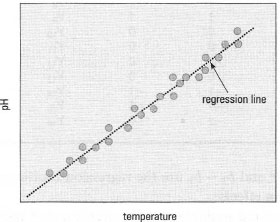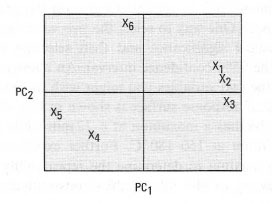Principal component analysis
The use of modern automated instrumentation allows the acquisition of large
amounts of chemical data. As well as simply tabulating the data, other forms of 'analysis' are required to interrogate the chemical information contained
within the data. One such approach, enabling the simplification of large data
sets by reducing the number of independent variables, is principal component
analysis (PCA). The basis of this approach is:
- To reduce the number of original independent variables into new axes,
so-called 'principal components', PCs, each of which can be estimated
unambiguously. The data contained in these new PCs, and which are
expressed as 'scores', are uncorrelated with each other.
- To express, in a few PCs, the amount of variation in the data.
- To have each new PC express a decreasing amount of variation.
An example of the application of peA is shown in Box 43.2.
 |
| Fig. 43.6 Determination of principal component 1. |
 |
| Fig. 43.7 Principal component analysis. |






